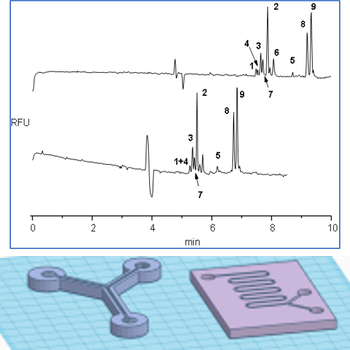
Figure 1: 3D printing slicer view of microfluidics schemes useful for CE-MS by electron ionization, and examples of electropherograms by CE-LEDIF of derivatized amino acids.
Research themes
1) Separation techniques at analytical and microanalytical scale (CE, UHPLC, GC-MS) addressed to bioactive compounds determination.
Chromatographic and electrokinetics methods are developed and applied to the determination of bioactive compounds in complex samples e.g., biological, natural extracts and environmental samples. The development involves the use and implementation of sample preparation techniques as solid-phase microextraction (SPME), solid-phase extraction (SPE) also by using sorbents based on molecular imprinting (MIP). Among the electrokinetic techniques, the research is addressed to the optimization of capillary isoelectric focusing (cIEF) methods aiming at the accurate and precise estimation of the isoelectric point of monoclonal antibodies (mAbs). The optimization and validation of the analytical methods is carried out by chemometric approaches as Design of Experiments (DoE) and Analytical Quality by Design (AQbD).
2) Implementation of detection systems for electrokinetics separation at microanalytical scale.
Laser-induced fluorescence (LIF) and light-emitting diode-induced fluorescence (LEDIF) are among the most sensitive detection approaches in CE. Only few compounds possess the native fluorescence to be directly detected by LIF and LEDIF, thus derivatization is often necessary to introduce into the target compounds the molecular moieties able to fluoresce under laser o LED excitation. The research is addressed to the development of derivatization techniques using novel fluorescent tags addressed to a variety of molecules of biological, pharmaceutical, and environmental interest. An original hyphenation mode for combining CE to mass spectrometry (MS) is developing by the direct introduction of the CE effluent into the electron impact (EI) source by means of home-made 3D-printed interfaces.
3) Microfluidics on paper
Paper based microfluidic devices have been employed for analytical monitoring in e.g., pharmaceutical, biological, environmental samples. Paper serves as an ideal substrate because of its affordability and easy waste management in addition to its intrinsic properties such as the ability to store reagents in the porous structure, capillary-driven fluid flow, biodegradability and biocompatibility for biological applications. Wax printing is the most used method for creating hydrophilic microfluidic pattern onto the paper bounded by hydrophobic zones. The research is aimed at applying chemometric approaches for optimizing the design and dimensions of the device. The detection signal is the colorimetric response inside the detection zone which is quantitatively analyzed by scanning and imaging software also using smartphone. Future advancements aim to integrate electrochemical detection by combining screen printed electrodes to increase the specificity and sensitivity of the platform.
